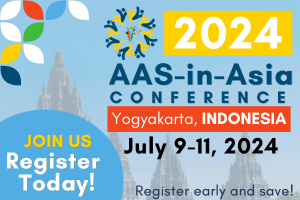| Browse and download close to 2,000 articles — feature articles, lesson plans, interviews, classroom resources, and book and film reviews — from Education About Asia (EAA)! |
| View the Editor’s Choice Articles — a curated list handpicked by EAA Founding Editor, Lucien Ellington, which provides an excellent overview of Education About Asia and introduction for new readers. |
Help us do more
by supporting EAA through donations.
How to use the EAA Online Search Engine
PLEASE NOTE: All article and essay illustrations, including many images and graphics necessary for understanding the content, may be viewed in the PDF.
-
1
Use the dropdown menus
to search by author, geographic location, article type, and academic field
-
2
Enter keywords
to search the full text of articles (where search terms may not appear in the article title, eg.)
-
3
View an article
by clicking on its title. To view the original print version of the article, select “PDF”
Search for Articles
NOTE: Archive articles may be downloaded and reproduced for personal or classroom use only.
Teaching about Myanmar and the Rohingya through One Man’s Eyes
Teaching About Asian War Refugees and Diaspora Experiences through Graphic Novels
Museums, Monuments, and Memorials: Commemorating the American War in Vietnam
Freedom Swimmer
Teaching Taiwan: An Experiential Learning Essay
Facts About Asia: The Modi Government and Religious Freedom
RRR (Rise, Roar, Revolt)
Teaching Christopher Harding’s The Japanese: A History in Twenty Lives in High Schools
How Singapore Sustains Its Market Autocracy
Pachinko Season 1
Understanding Daily Life in Wartime Japan, 1937-1945
Highlights of the 2022 Freeman and South Asia Book Award Winners
Book Review Essay, Feature Article
The Story of a Family Divided by the Communist Revolution in China
The Problem That Has No Name
Daughters of the Flower Fragrant Garden in the Classroom
A Family Separated by the Bamboo Curtain
An EAA Interview with Lauren McKee Author of Japanese Government and Politics An AAS Key Issues in Asian Studies Publication
New to EAA?
Before viewing the full archives, view Editor’s Choice Articles, which provide a good overview of EAA and introduction for new readers.
Most Viewed Articles
- The British Impact on India, 1700–1900
- Japan’s Motives for Bombing Pearl Harbor, 1941
- The Korean War 101: Causes, Course, and Conclusion of the Conflict
- China's Great Leap Forward
- The History of Economic Development in India since Independence
- The Philippines: An Overview of the Colonial Era
- Wu Zhao: Ruler of Tang Dynasty China
- Teaching about the Comfort Women during World War II and the Use of Personal Stories of the Victims
- America and the Philippines: Modern Civilization and City Planning
- Leaving North Korea: My Story




